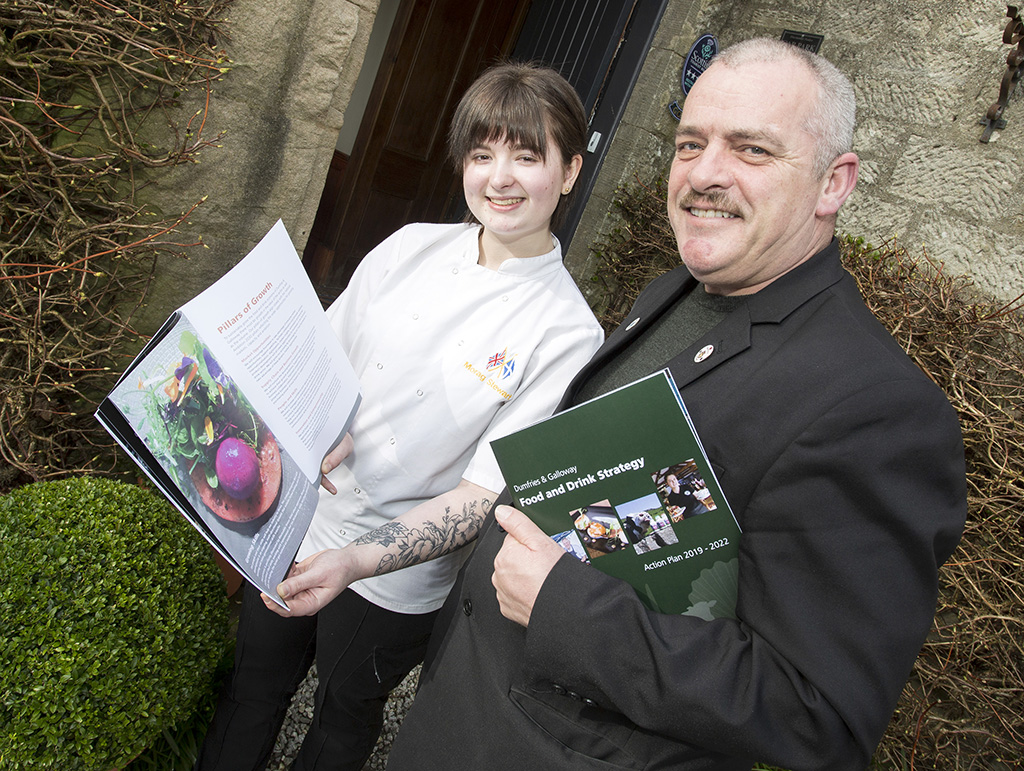
Food and drink strategy launched in southern Scotland
Dumfries and Galloway has launched the first food and drink strategy for the region.
The local council is putting a focus on supporting collaboration, innovation, job creation and inclusive growth across the sector.
The strategy was formally adopted by Dumfries and Galloway Council late last year, and was launched by 18-year-old Morag Stewart, apprentice chef at Blackaddie House Hotel in Sanquhar, and by Councillor Archie Dryburgh.
It highlights food tourism and skills development as particular opportunities for the region, and suggests that the industry could be ‘the foundation of Dumfries and Galloway’s future economic resilience, creating employment and business opportunities in almost every community of our region’.
The strategy has been developed over the past year following extensive consultation with industry partners and it sets an ambitious target to double the value of Dumfries and Galloway’s food and drink industry to £2.5 billion by 2030. The growth ambition aligns with the national strategy, ‘Ambition 2030’ which aims to double the value of Scotland’s industry over the next 12 years.
Food and drink is already Dumfries and Galloway’s largest, fastest growing and most valuable economic sector, with an annual turnover of £1.2 billion; accounting for 25% of all private sector economic activity. Spanning the full supply chain from field and sea to plate, the sector includes primary production, such as agriculture and fishing, through to small food producers, large scale food manufacturers and processors, farmers’ markets and food festivals, distributors, restaurants, cafes, visitor attractions, speciality retailers and a growing number of distilleries.
Morag Stewart, whose social media photography is featured in the strategy as an example of inter-generational skills transfer, said: ‘I’m really pleased to help launch this strategy as it is all about the future of my industry. I’m going in to the second year of my apprenticeship and I have already learned so much. It’s good to see the Council supporting the food and drink industry and highlighting the training and job opportunities in it for young people in Dumfries & Galloway.’

Morag Stewart and Archie Dryburgh
Archie Dryburgh, chair of the economy, environment and infrastructure committee, said: ‘Our council committed to deliver an ambitious regional Food and Drink Strategy last year and I’m very pleased to see it now adopted as council policy.
‘I’m particularly pleased to launch it during Scottish Tourism Month. Food tourism is highlighted as an opportunity within this strategy, and there are a number of practical steps we can take to help grow our region’s two most important industries in parallel with each other. Food and drink is an essential part of the tourism experience, and this strategy will help us deliver for both these industries.’
Andrew Wood, vice chair of the economy, environment and infrastructure committee, said: ‘Dumfries and Galloway is already one of Scotland’s most important food producing regions and it is essential that we build on our natural strengths in planning for a more successful, resilient and sustainable economy.’
The publication of the strategy was welcomed by Ian McAndrew, chef proprietor of Blackaddie House Hotel, who employs and trains Morag as an apprentice chef, and who chairs of Visit South West Scotland.
Ian said: ‘Both our tourism and our food and drink industries need to focus on quality, and quality is only achieved by combining quality training and quality produce; both are essential to deliver quality on the plate. I welcome the approach taken in this strategy, particularly its focus on skills development and knowledge sharing across the industry.
‘There is huge potential in our people and in our produce, and Morag is a great example of that potential. She is a first class model student with a very bright future in the industry, and it is a privilege to support her in developing her potential.’
James Withers, chief executive of Scotland and Drink, added: ‘This is an important and exciting development. Scotland Food and Drink’s national strategy, Ambition 2030, is based on a belief that despite the short term challenges, there are huge opportunities for our industry ahead of us.
‘Dumfries and Galloway is already an engine room for the nation’s agriculture industry, creating the raw material for world class food and drink products. I believe this plan can now unlock the region’s full potential, with all the benefits that will bring to communities and the local economy. Collaboration is a central theme of the strategy; it will be central to success. I look forward to working with partners in the region to drive the industry forward over the next few years.’
The Dumfries and Galloway Food and Drink Strategy and Prioritised Action Plan can be downloaded from www.dgfoodanddrink.org
TAGS

